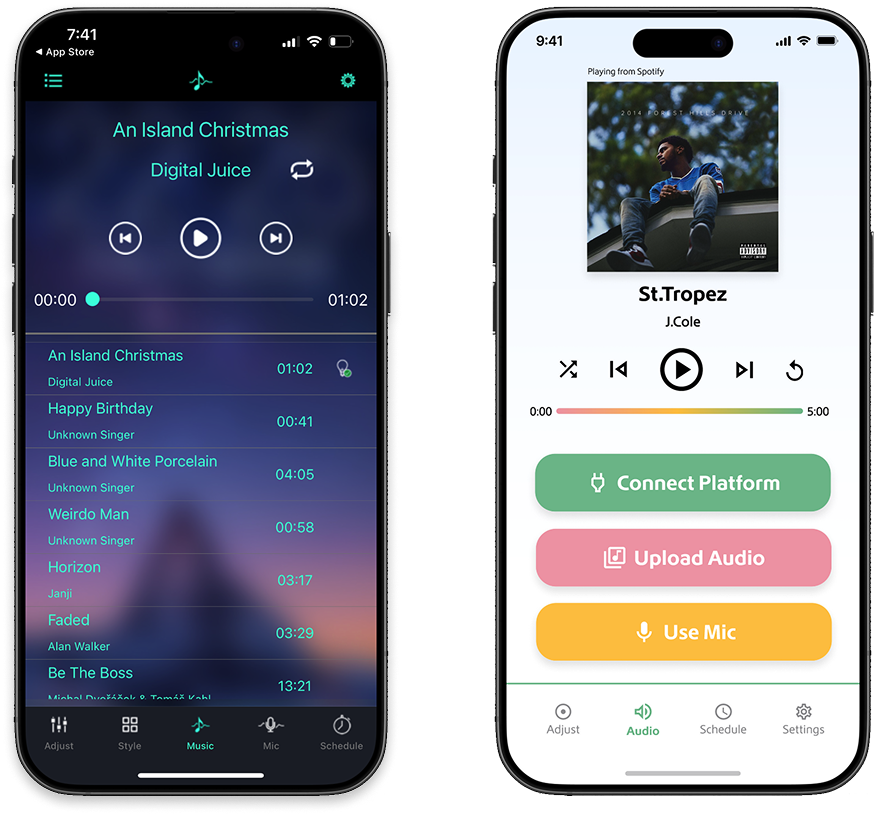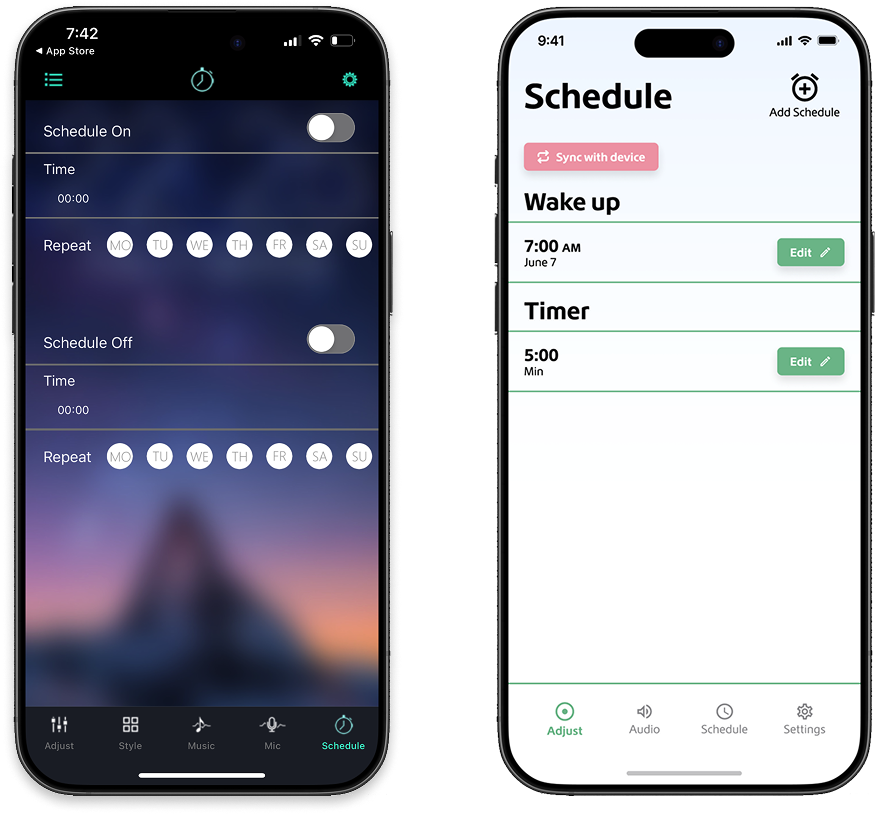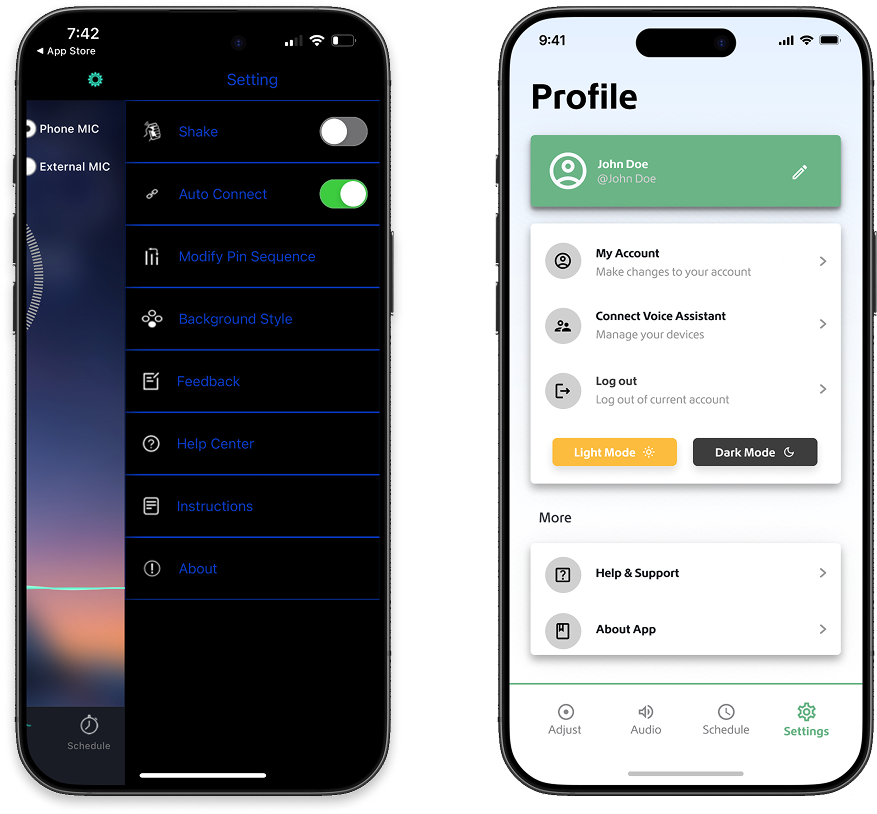Lostus Lantern: App redesign
I redesigned the most visited and displayed pages of the Lotus Lantern mobile app. I leveraged strategic insights, defined key metrics, determined key user behaviors, presented concepts, and delivered a refined final design.

Smart home technology and consumer electronics
The app requires a thorough reorganization and redesign to enhance user engagement. This includes creating a more intuitive information architecture and establishing a cohesive visual language for a seamless and visually appealing experience.
7 Weeks
User Research, UX & UI Design, Prototyping
PowerPoint, Figma, Photoshop, Illustrator
From Functionality to Usability
Lotus Lantern is a versatile and popular app for controlling LED lights via Bluetooth or Wi-Fi. It allows users to customize the colors, brightness, and effects of their LED lighting systems, often used in smart lighting setups for homes, cars, or decorations.
For an assignment, I was tasked with selecting a product with an accompanying app that required improvement and creating a redesigned version. I chose to take on the challenge of redesigning the Lotus Lantern app to enhance its functionality and user experience.
The challenge that needs to be addressed
Despite Lotus Lantern's vision of connecting users with affordable products through its app, the current version suffers from significant design and functional shortcomings that undermine its effectiveness and user satisfaction. The app's interface is often criticized for being confusing and cluttered, leading to a frustrating user experience. Additionally, frequent performance issues, such as slow load times and unreliable functionality, further diminish its usability.
To address these challenges, Lotus Lantern must focus on resolving these critical design and functionality issues. Improving the app's user interface, optimizing performance, and expanding support and customization features are essential steps toward creating a more effective and user-friendly digital experience.
Previous App Interface
The app feels cluttered and outdated, with confusing navigation, small controls, and laggy interactions. Key features are buried, presets are limited, and the overall design lacks the polish of modern smart-home apps.
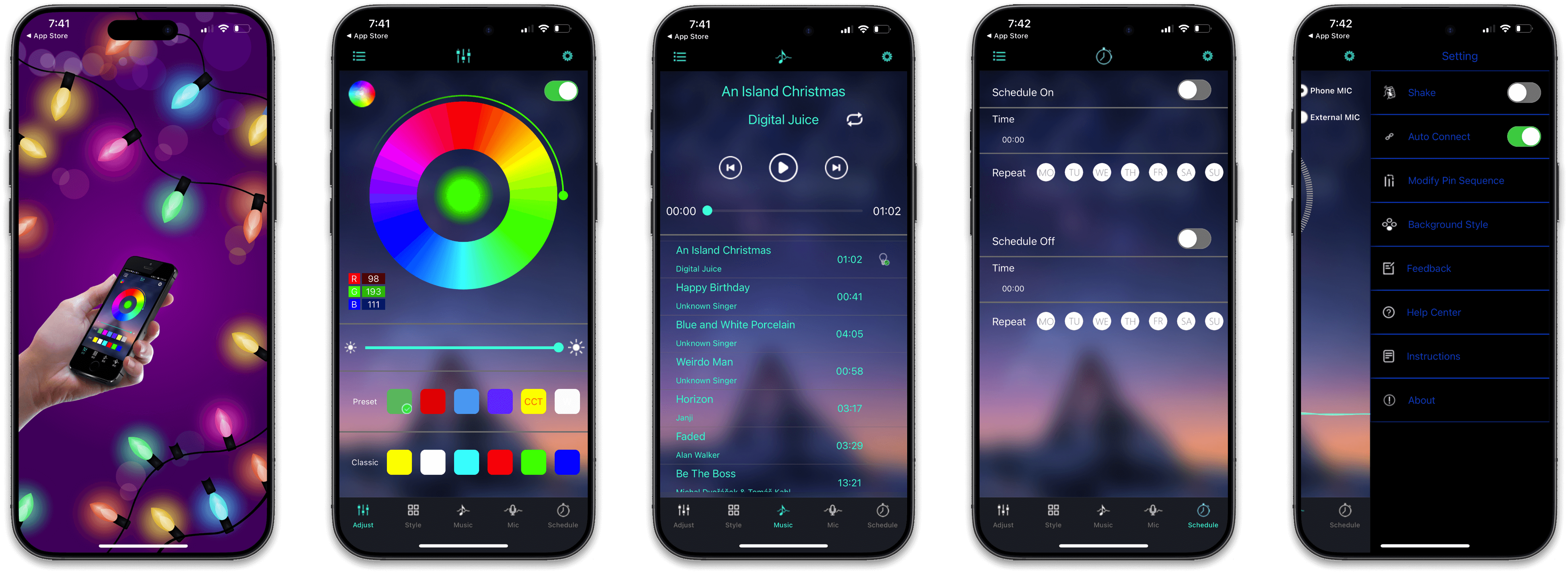
Determining business and user goals
What do they want to achieve with this product? What need does it fill?
Innovate the app to include new features, improve user interface, allow connection to streaming platforms, and enhance connectivity with other smart home devices.
Continuouslyimprove the RGB technology for better color accuracy, energy efficiency, andlonger lifespan.
Developand introduce new types of LED lights or accessories to meet diverse customerneeds and preferences to drive more sales.
Users want a seamless and enjoyable experience, with a straightforward interface that is intuitive, easy to navigate, and simplifies the app. They also want to control and customize lighting effortlessly through a simple, easy-to-follow process.
Users want to be able to connect to streaming platform apps to sync their own music playlists and Integrate with voice assistants like Alexa or Google Assistant for hands-free control.
They want the option for the LED lights work well with other smart home devices and systems, such as smart thermostats or security systems.
Product Analysis
The LED lights offer a variety of colors and lighting effects that users can customize to match their preferences or moods.
ii. App Control:
The app allows users to control the lights remotely, adjust settings, and create customized lighting scenes.
iii. Scheduling and Automation:
Users can set schedules for when the lights should turn on or off and automate lighting changes based on specific triggers or times.
Versatility and Customization: Users appreciate the range of colors and effects, as well as the ability to create personalized lighting setups.
ii. Negative Reviews:
App Performance: Occasional complaints about the app being buggy or slow.
Music Sync Feature:
The app only allows base songs to sync with the lights, rather than connecting to streaming platforms.
The ability to manage lighting from anywhere using the app is a key feature that enhances user control and flexibility.
ii. Flexible Scheduling and Automation:
It provides convenience by allowing users to set schedules and automate lighting based on various triggers.
iii. Advanced Color & Effect Customization:
The ability to choose from a broad spectrum of colors and various lighting effects is a standout feature.
Market Competitor Analysis: Philips Hue
Target Market Research
Age: 14–35
Gender: 30% male, 50% female
Education: High school or higher
Occupation: Part-time intern
Annual Income: $20,000+
1. Tech-savvy
2. Aesthetic- and design-oriented
3. Trend-conscious
4. Gaming enthusiast
Developed countries
Tech-savvy regions
Suburban/urban areas
Colleges
Age: 35–50
Gender: 30% male, 50% female
Education: Degree or higher
Occupation: Designer
Annual Income: $90,000+
1. Tech-savvy
2. Home improvement enthusiast
3. Family-oriented
4. Leisure-focused
Home improvement-focused areas
Tech-savvy regions
Suburban/urban areas
Regions with a strong tech retail presence
User Personas
Defining key user types to guide the redesign
App High fidelity Interface Sketches
These detailed interface sketches visualize the redesigned app in its final form. They highlight a clean aesthetic, intuitive navigation, and seamless user control.

Sketch Phone Mockups
Each screen emphasizes usability, clarity, and a modern smart-lighting experience.




Moad Board

A visual exploration of colors, fonts, and styles that capture the essence of the redesigned Lotus Lantern app. This board defines the overall mood, guiding the aesthetic and emotional tone of the user experience.
Journey Map Diagram

Product & User Flow Diagrams
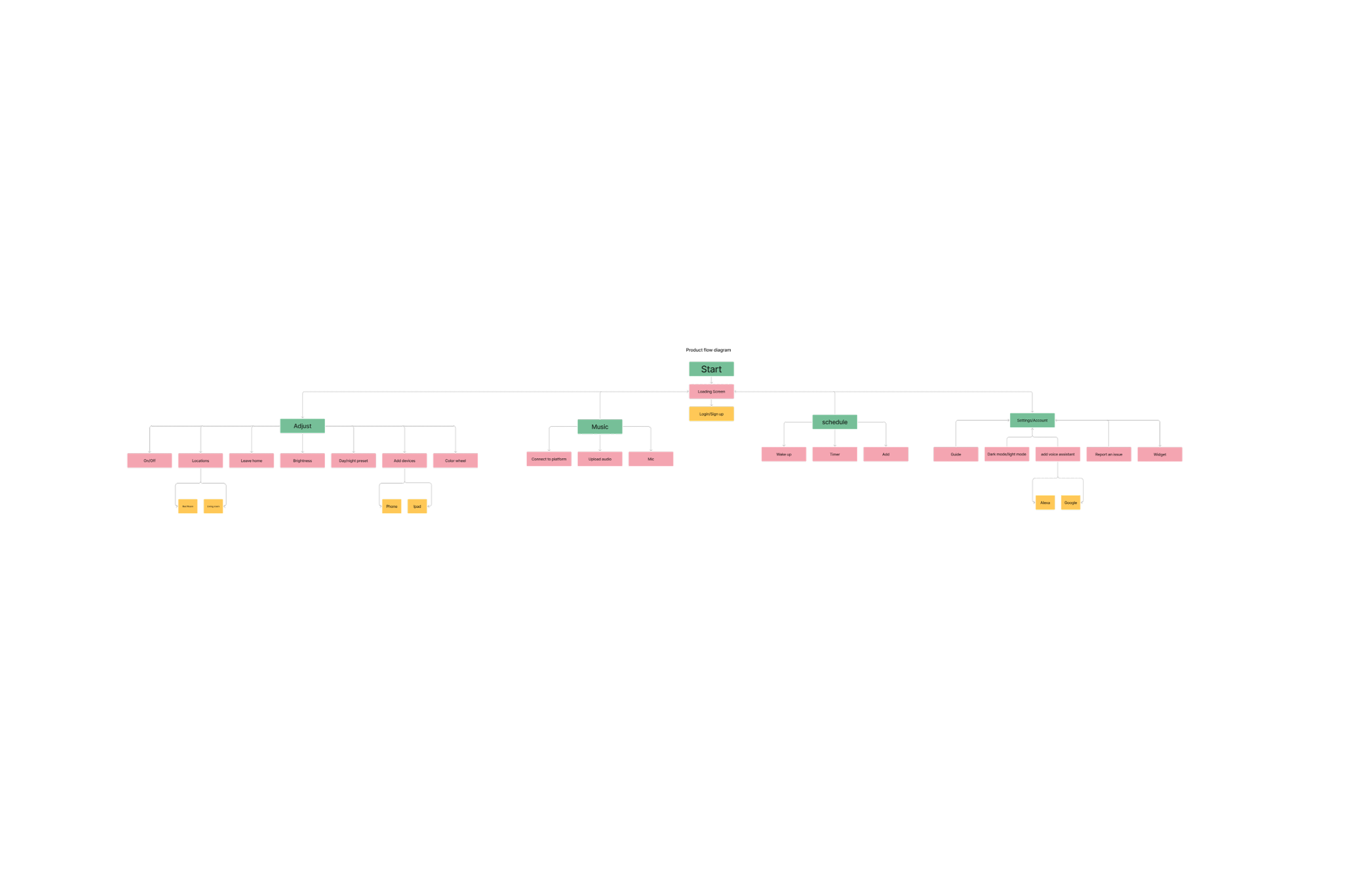
Product Flow Diagram
The product flow of the Lotus Lantern app begins with users logging in, followed by selecting or customizing lighting modes through the main control interface. From there, users can adjust brightness, set schedules, or activate effects like music sync to personalize their lighting experience.

User Flow Diagram
The user flow diagram illustrates how users navigate through the app, from logging in or signing up and accessing the home dashboard to customizing lighting settings and saving preferred modes. It maps out the login and music sync proccess of the app.
Focus Group Feedback
There are areas for improvement, particularly in terms of accessibility, customization options, and advanced features. Key findings include a desire for more visual clarity in the app interface and additional options for users with visual impairments. Users were also interested in hidden features and advanced settings, but the current options were deemed too limited. Customization options were generally appreciated, but people suggested more preset color schemes and a function with greater control over transition speeds.”
Group Guidelines
This focus group research was conducted October 2, 2024 at 6:30pm. For the full focus group research details view the case study files.
Participants
Questions
Focus Group Summary
The new Lotus Lantern app has received good feedback but needs improvements in accessibility, customization, and advanced features. Users want a clearer interface, more options for visual impairments, and more hidden features and settings. They also desire more color schemes and control over transitions.
Download Case Study FilesNew App Interface
The app feels cluttered and outdated, with confusing navigation, small controls, and laggy interactions. Key features are buried, presets are limited, and the overall design lacks the polish of modern smart-home apps.
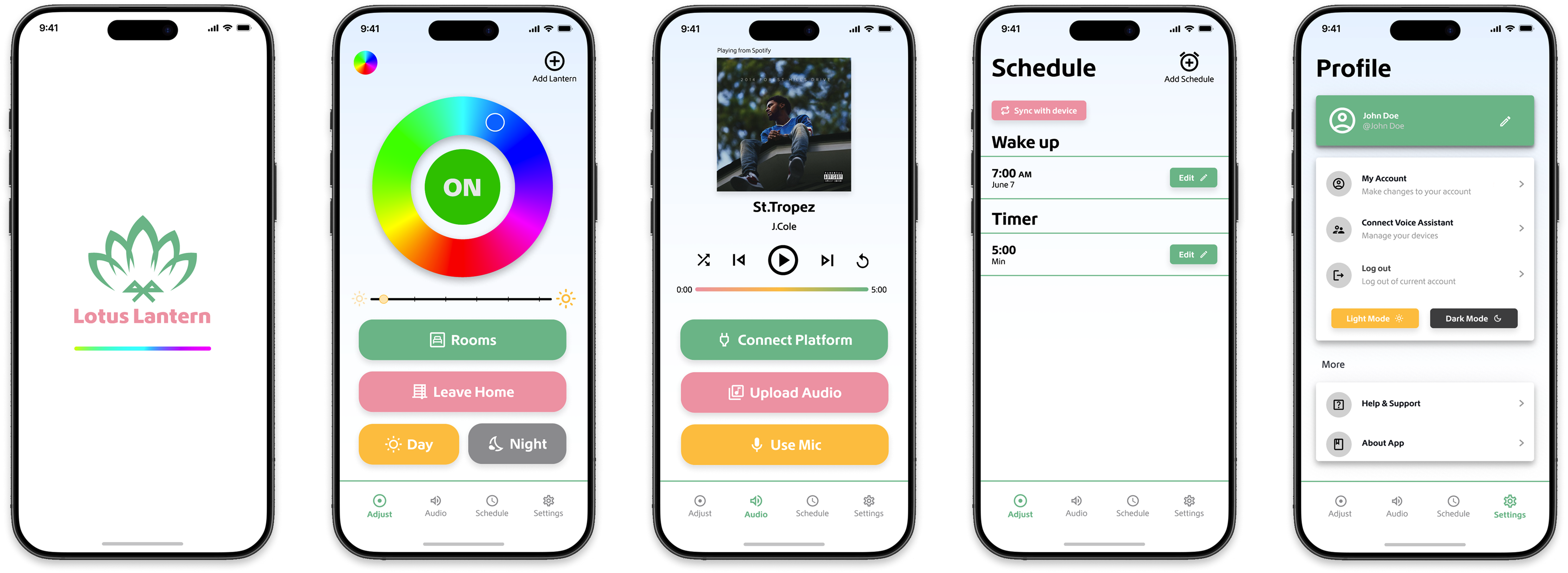
Image Gallery
Both versions of the app in comparison





